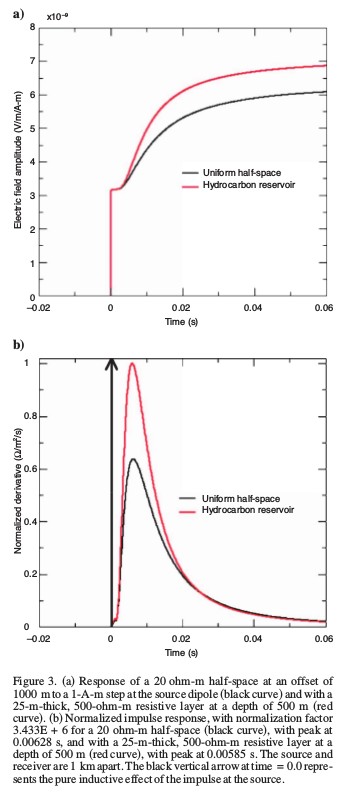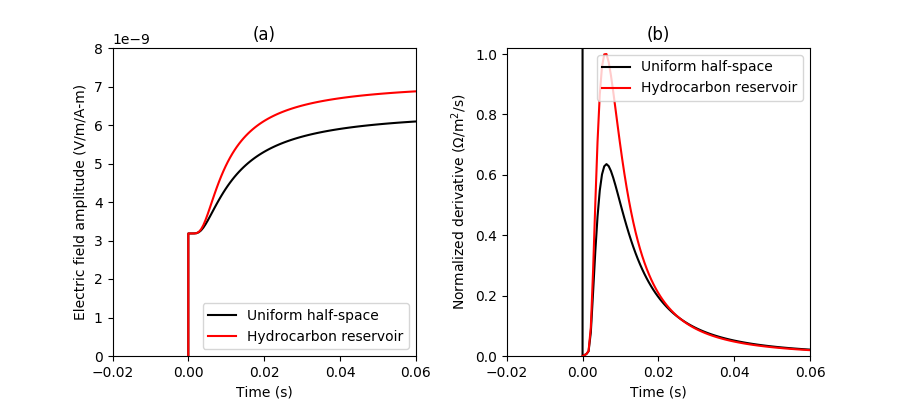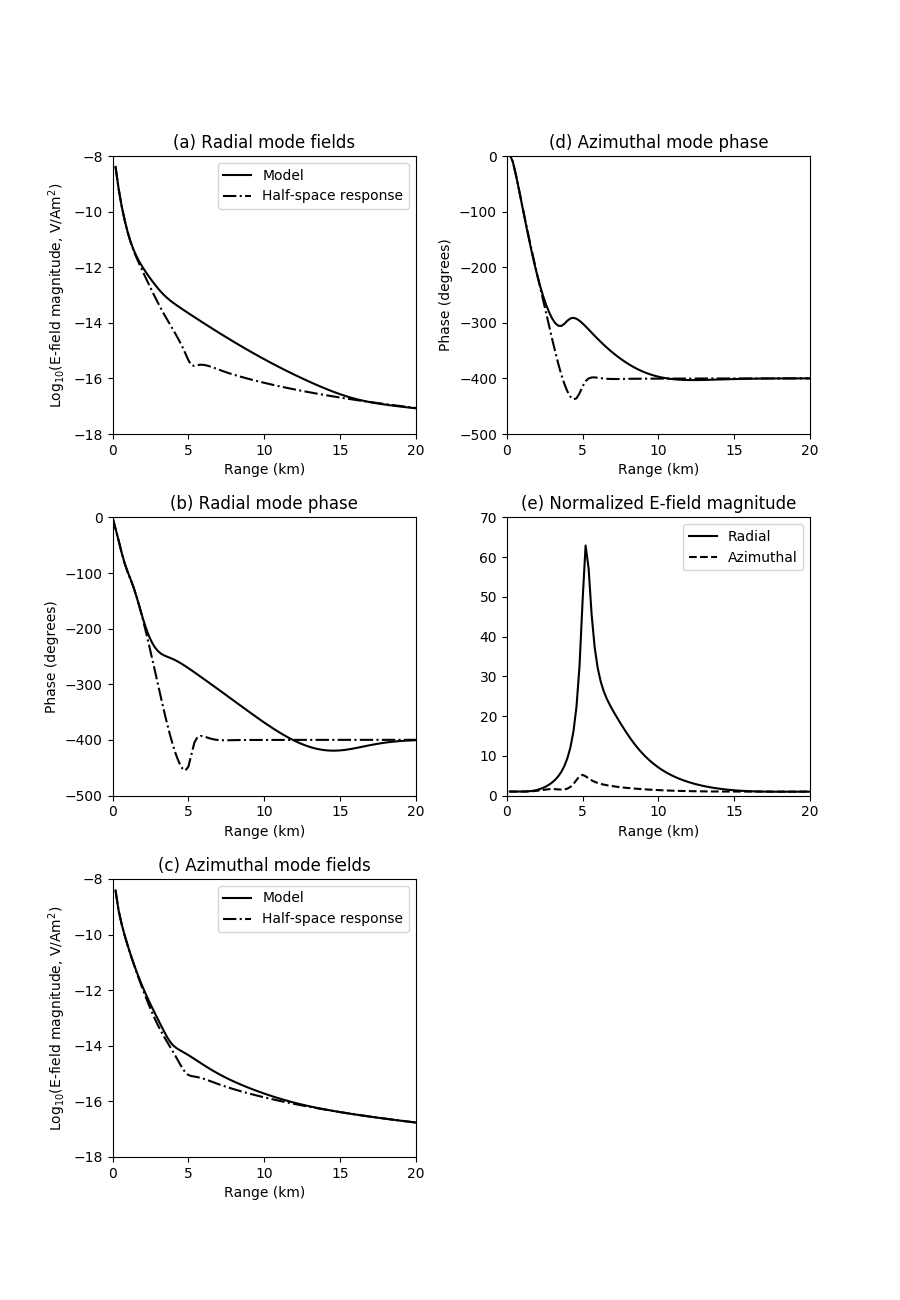Note
Click here to download the full example code
CSEM¶
Reproducing a few published results in the field of Controlled-Source Electromagnetics. So far there are only two examples, Ziolkowski et al., 2007, Figure 3 and Constable and Weiss, 2006, Figure 3. notebooks.
More examples could be implemented. In the references are some papers listed that have interesting 1D modelling results.
References
- Constable, S., and C.~J. Weiss, 2006, Mapping thin resistors and hydrocarbons with marine EM methods: Insights from 1d modeling Geophysics, 71, G43-G51; DOI: 10.1190/1.2187748.
- Constable, S., 2010, Ten years of marine CSEM for hydrocarbon exploration: Geophysics, 75, 75A67-75A81; DOI: 10.1190/1.3483451.
- MacGregor, L., and J. Tomlinson, 2014, Marine controlled-source electromagnetic methods in the hydrocarbon industry: A tutorial on method and practice: Interpretation, 2, SH13-SH32; DOI: 10.1190/INT-2013-0163.1.
- Ziolkowski, A., B. Hobbs, and D. Wright, 2007, Multitransient electromagnetic demonstration survey in france Geophysics, 72, F197-F209; DOI: 10.1190/1.2735802.
- Ziolkowski, A., and D. Wright, 2012, The potential of the controlled source electromagnetic method: A powerful tool for hydrocarbon exploration, appraisal, and reservoir characterization Signal Processing Magazine, IEEE, 29, 36-52; DOI: 10.1109/MSP.2012.2192529.
import empymod
import numpy as np
from copy import deepcopy as dc
import matplotlib.pyplot as plt
1. Ziolkowski et al. (2007), Figure 3¶
A land MTEM example.

Calculation¶
# Time
t = np.linspace(0.001, 0.06, 101)
# Target model
inp2 = {'src': [0, 0, 0.001],
'rec': [1000, 0, 0.001],
'depth': [0, 500, 525],
'res': [2e14, 20, 500, 20],
'freqtime': t,
'verb': 1}
# HS model
inp1 = dc(inp2)
inp1['depth'] = inp2['depth'][0]
inp1['res'] = inp2['res'][:2]
# Calculate responses
sths = empymod.dipole(**inp1, signal=1) # Step, HS
sttg = empymod.dipole(**inp2, signal=1) # " " Target
imhs = empymod.dipole(**inp1, signal=0, ft='fftlog') # Impulse, HS
imtg = empymod.dipole(**inp2, signal=0, ft='fftlog') # " " Target
Plot¶
plt.figure(figsize=(9, 4))
plt.subplots_adjust(wspace=.3)
# Step response
plt.subplot(121)
plt.title('(a)')
plt.plot(np.r_[0, 0, t], np.r_[0, sths[0], sths], 'k',
label='Uniform half-space')
plt.plot(np.r_[0, 0, t], np.r_[0, sttg[0], sttg], 'r',
label='Hydrocarbon reservoir')
plt.axis([-.02, 0.06, 0, 8e-9])
plt.xlabel('Time (s)')
plt.ylabel('Electric field amplitude (V/m/A-m)')
plt.legend()
# Impulse response
plt.subplot(122)
plt.title('(b)')
# Normalize by max-response
ntg = np.max(np.r_[imtg, imhs])
plt.plot(np.r_[0, 0, t], np.r_[2, 0, imhs/ntg], 'k',
label='Uniform half-space')
plt.plot(np.r_[0, t], np.r_[0, imtg/ntg], 'r', label='Hydrocarbon reservoir')
plt.axis([-.02, 0.06, 0, 1.02])
plt.xlabel('Time (s)')
plt.ylabel(r'Normalized derivative ($\Omega$/m$^2$/s)')
plt.legend()
plt.show()

2. Constable and Weiss (2006), Figure 3¶
Note: Exact reproduction is not possible, as source and receiver depths are not explicitly specified in the publication. I made a few checks, and it looks like a source-depth of 900 meter gives good accordance. Receivers are on the sea-floor.

Calculation¶
# Offsets
x = np.linspace(0, 20000, 101)
# TG model
inp3 = {'src': [0, 0, 900],
'rec': [x, np.zeros(x.shape), 1000],
'depth': [0, 1000, 2000, 2100],
'res': [2e14, 0.3, 1, 100, 1],
'freqtime': 1,
'verb': 1}
# HS model
inp4 = dc(inp3)
inp4['depth'] = inp3['depth'][:2]
inp4['res'] = inp3['res'][:3]
# Calculate radial responses
rhs = empymod.dipole(**inp4) # Step, HS
rhs = empymod.utils.EMArray(np.nan_to_num(rhs))
rtg = empymod.dipole(**inp3) # " " Target
rtg = empymod.utils.EMArray(np.nan_to_num(rtg))
# Calculate azimuthal response
ahs = empymod.dipole(**inp4, ab=22) # Step, HS
ahs = empymod.utils.EMArray(np.nan_to_num(ahs))
atg = empymod.dipole(**inp3, ab=22) # " " Target
atg = empymod.utils.EMArray(np.nan_to_num(atg))
Out:
* WARNING :: Offsets < 0.001 m are set to 0.001 m!
* WARNING :: Offsets < 0.001 m are set to 0.001 m!
* WARNING :: Offsets < 0.001 m are set to 0.001 m!
* WARNING :: Offsets < 0.001 m are set to 0.001 m!
Plot¶
plt.figure(figsize=(9, 13))
plt.subplots_adjust(wspace=.3, hspace=.3)
# Radial amplitude
plt.subplot(321)
plt.title('(a) Radial mode fields')
plt.plot(x/1000, np.log10(rtg.amp), 'k', label='Model')
plt.plot(x/1000, np.log10(rhs.amp), 'k-.', label='Half-space response')
plt.axis([0, 20, -18, -8])
plt.xlabel('Range (km)')
plt.ylabel(r'Log$_{10}$(E-field magnitude, V/Am$^2$)')
plt.legend()
# Radial phase
plt.subplot(323)
plt.title('(b) Radial mode phase')
plt.plot(x/1000, rtg.pha, 'k')
plt.plot(x/1000, rhs.pha, 'k-.')
plt.axis([0, 20, -500, 0])
plt.xlabel('Range (km)')
plt.ylabel('Phase (degrees)')
# Azimuthal amplitude
plt.subplot(325)
plt.title('(c) Azimuthal mode fields')
plt.plot(x/1000, np.log10(atg.amp), 'k', label='Model')
plt.plot(x/1000, np.log10(ahs.amp), 'k-.', label='Half-space response')
plt.axis([0, 20, -18, -8])
plt.xlabel('Range (km)')
plt.ylabel(r'Log$_{10}$(E-field magnitude, V/Am$^2$)')
plt.legend()
# Azimuthal phase
plt.subplot(322)
plt.title('(d) Azimuthal mode phase')
plt.plot(x/1000, atg.pha+180, 'k')
plt.plot(x/1000, ahs.pha+180, 'k-.')
plt.axis([0, 20, -500, 0])
plt.xlabel('Range (km)')
plt.ylabel('Phase (degrees)')
# Normalized
plt.subplot(324)
plt.title('(e) Normalized E-field magnitude')
plt.plot(x/1000, np.abs(rtg/rhs), 'k', label='Radial')
plt.plot(x/1000, np.abs(atg/ahs), 'k--', label='Azimuthal')
plt.axis([0, 20, 0, 70])
plt.xlabel('Range (km)')
plt.legend()
plt.show()

empymod.Report()
Total running time of the script: ( 0 minutes 1.992 seconds)
Estimated memory usage: 8 MB